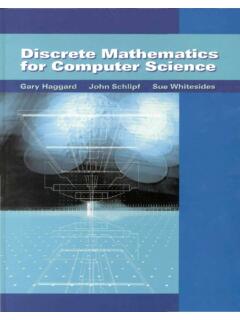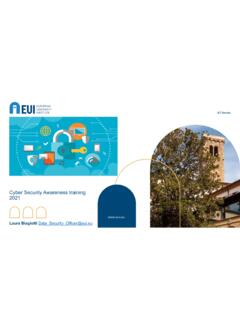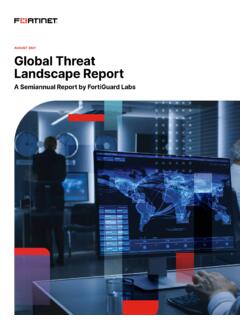Transcription of Fake Review Detection: Classification and Analysis of Real ...
1 Fake Review Detection: Classification and Analysis of Real and Pseudo Reviews Arjun Mukherjee , Vivek Venkataraman , Bing Liu , Natalie Glance .. University of Illinois at Chicago, Google Inc. ABSTRACT incentives for imposters to game the system by posting fake In recent years, fake Review detection has attracted significant reviews to promote or to discredit some target products or attention from both businesses and the research community. For businesses. Such individuals are called opinion spammers and reviews to reflect genuine user experiences and opinions, detecting their activities are called opinion spamming. In the past few years, fake reviews is an important problem. Supervised learning has the problem of spam or fake reviews has become widespread, and been one of the main approaches for solving the problem. many high-profile cases have been reported in the news [44, 48]. However, obtaining labeled fake reviews for training is difficult Consumer sites have even put together many clues for people to because it is very hard if not impossible to reliably label fake manually spot fake reviews [38].
2 There have also been media reviews manually. Existing research has used several types of investigations where fake reviewers blatantly admit to have been pseudo fake reviews for training. Perhaps, the most interesting paid to write fake reviews [19]. The Analysis in [34] reports that type is the pseudo fake reviews generated using the Amazon many businesses have tuned into paying positive reviews with Mechanical Turk (AMT) crowdsourcing tool. Using AMT crafted cash, coupons, and promotions to increase sales. In fact the fake reviews, [36] reported an accuracy of using only menace created by rampant posting of fake reviews have soared to word n-gram features. This high accuracy is quite surprising and such serious levels that has launched a sting operation very encouraging. However, although fake, the AMT generated to publicly shame businesses who buy fake reviews [43]. reviews are not real fake reviews on a commercial website. The Since it was first studied in [11], there have been various Turkers (AMT authors) are not likely to have the same extensions for detecting individual [25] and group [32] spammers, psychological state of mind while writing such reviews as that of and for time-series [52] and distributional [9] Analysis .
3 The main the authors of real fake reviews who have real businesses to detection technique has been supervised learning. Unfortunately, promote or to demote. Our experiments attest this hypothesis. due to the lack of reliable or gold-standard fake Review data, Next, it is naturally interesting to compare fake Review detection existing works have relied mostly on ad-hoc fake and non-fake accuracies on pseudo AMT data and real-life data to see whether labels for model building. In [11], supervised learning was used different states of mind can result in different writings and with a set of Review centric features ( , unigrams and Review consequently different Classification accuracies. For real Review length) and reviewer and product centric features ( , average data, we use filtered (fake) and unfiltered (non-fake) reviews from rating, sales rank, etc.) to detect fake reviews. Duplicate and near (which are closest to ground truth labels) to perform a duplicate reviews were assumed to be fake reviews in training.
4 An comprehensive set of Classification experiments also employing AUC (Area Under the ROC Curve) of was reported using only n-gram features. We find that fake Review detection on logistic regression. The assumption, however, is too restricted for Yelp's real-life data only gives accuracy, but this accuracy detecting generic fake reviews. The work in [24] used similar still indicates that n-gram features are indeed useful. We then features but applied a co-training method on a manually labeled propose a novel and principled method to discover the precise dataset of fake and non-fake reviews attaining an F1-score of difference between the two types of Review data using the The result too may not be completely reliable due to the noise information theoretic measure KL-divergence and its asymmetric induced by human labels in the dataset. Accuracy of human property. This reveals some very interesting psycholinguistic labeling of fake reviews has been shown to be quite poor [36].
5 Phenomena about forced and natural fake reviewers. To improve Another interesting thread of research [36] used Amazon Classification on the real Yelp Review data, we propose an Mechanical Turk (AMT) to manufacture (by crowdsourcing) fake additional set of behavioral features about reviewers and their hotel reviews by paying (US$1 per Review ) anonymous online reviews for learning, which dramatically improves the workers (called Turkers) to write fake reviews by portraying a Classification result on real-life opinion spam data. hotel in a positive light. 400 fake positive reviews were crafted Categories and Subject Descriptors using AMT on 20 popular Chicago hotels. 400 positive reviews [Natural Language Processing]: Text Analysis ; from on the same 20 Chicago hotels were used as [Computer Applications]: Social and Behavioral Sciences non-fake reviews. The authors in [36] reported an accuracy of using only word bigram features. Further, [8] used some General Terms deep syntax rule based features to boost the accuracy to Experimentation, Measurement The significance of the result in [36] is that it achieved a very Keywords high accuracy using only word n-gram features, which is both very Opinion spam, Fake Review detection, Behavioral Analysis surprising and also encouraging.
6 It reflects that while writing fake reviews, people do exhibit some linguistic differences from other 1. INTRODUCTION genuine reviewers. The result was also widely reported in the Online reviews are increasingly used by individuals and news , , The New York Times [45]. However, a weakness of organizations to make purchase and business decisions. Positive this study is its data. Although the reviews crafted using AMT are reviews can render significant financial gains and fame for fake, they are not real fake reviews on a commercial website. businesses and individuals. Unfortunately, this gives strong The Turkers are not likely to have the same psychological state of mind when they write fake reviews as that of authors of real fake reviews who have real business interests to promote or to demote. If a real fake reviewer is a business owner, he/she knows the Technical Report, Department of Computer Science (UIC-CS-2013-03). business very well and is able to write with sufficient details, University of Illinois at Chicago.
7 Rather than just giving glowing praises of the business. He/she will overdone it in making their reviews sound genuine as it has left also be very careful in writing to ensure that the Review sounds footprints of linguistic pretense. The combination of the two genuine and is not easily spotted as fake by readers. If the real fake findings explains why the accuracy is better than 50% (random). reviewer is paid to write, the situation is similar although he/she but much lower than that of the AMT data set. may not know the business very well, this may be compensated by The next interesting question is: Is it possible to improve the his/her experiences in writing fake reviews. In both cases, he/she Classification accuracy on the real-life Yelp data? The answer is has strong financial interests in the product or business. However, yes. We then propose a set of behavioral features of reviewers and for an anonymous Turker, he/she is unlikely to know the business their reviews.
8 This gives us a large margin improvement as we well and does not need to write carefully to avoid being detected will see in 6. What is very interesting is that using only the new because the data was generated for research, and each Turker was behavioral features alone does significantly better than bigrams only paid US$1 for writing a Review . This means that his/her used in [36]. Adding bigrams only improve performance slightly. psychological state of mind while writing can be quite different To conclude this section, we also note the other related works from that of a real fake reviewer. Consequently, their writings may on opinion spam detection. In [12], different reviewing patterns be very different, which is indeed the case as we will see in 2, 3. are discovered by mining unexpected class association rules. In To obtain an in-depth understanding of the underlying [25], some behavioral patterns were designed to rank reviews. In phenomenon of opinion spamming and the hardness for its [49], a graph-based method for finding fake store reviewers was detection, it is scientifically very interesting from both the fake proposed.
9 None of these methods perform Classification of fake Review detection point of view and the psycholinguistic point of and non-fake reviews which is the focus of this work. Several view to perform a comparative evaluation of the Classification researchers also investigated Review quality [ , 26, 54] and results of the AMT dataset and a real-life dataset to assess the helpfulness [17, 30]. However, these works are not concerned with difference. This is the first part of our work. Fortunately, spamming. A study of bias, controversy and summarization of has excellent data for this experiment. is one research paper reviews was reported in [22, 23]. This is a different of the largest hosting sites of business reviews in the United problem as research paper reviews do not (at least not obviously). States. It filters reviews it believes to be suspicious. We crawled involve faking. In a wide field, the most investigated spam its filtered (fake) and unfiltered (non-fake) reviews.
10 Although, the activities have been Web spam [1, 3, 5, 35, 39, 41, 42, 52, 53, 55]. Yelp data may not be perfect, its filtered and unfiltered reviews are and email spam [4]. Recent studies on spam also extended to blogs likely to be the closest to the ground truth of real fake and non- [18, 29], online tagging [20], clickbots [16], and social networks fake reviews since Yelp engineers have worked on the problem [13]. However, the dynamics of all these forms of spamming are and been improving their algorithms for years. They started to quite different from those of opinion spamming in reviews. work on filtering shortly after their launch in 2004 [46]. Yelp is We now summarize the main results/contributions of this paper: also confident enough to make its filtered and unfiltered reviews known to the public on its Web site. We will further discuss the 1. It performs a comprehensive set of experiments to compare quality of Yelp's filtering and its impact on our Analysis in 7.









